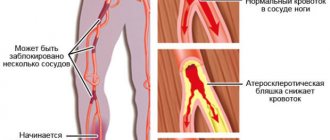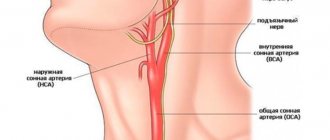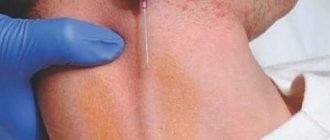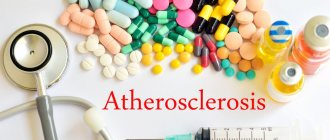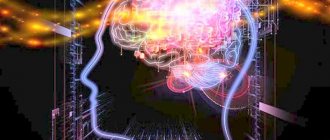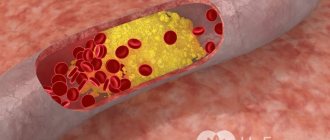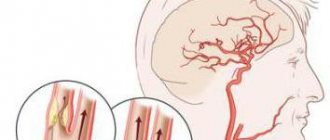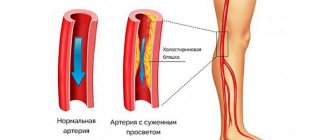Cholesterol plaques in the blood vessels of the brain are a manifestation of cerebral atherosclerosis. They become an obstacle to blood circulation in the bloodstream, which results in poor circulation.
With this disease, the brain experiences oxygen starvation and a lack of nutrients, which is fraught with irreversible changes in its tissues and increases the risk of stroke.
Atherosclerosis
The main arteries of the neck are the carotid and vertebral arteries, originating in the chest cavity. They supply blood to the brain tissue. With atherosclerosis, blood supply is disrupted as fatty plaques form on the inner surface of the vessels. Gradually, connective tissue grows in them, and solid calcium salts accumulate.
Composition of atherosclerotic plaques:
- lipids (fats), mainly cholesterol;
- connective tissue;
- immune cells;
- calcium salts;
- fibrin.
The destruction of a plaque in a neck artery leads to the appearance in the blood of pieces of various shapes and sizes, which can close the lumen of blood vessels in parts of the brain and cause a stroke. The most dangerous are solid formations, which are dominated by calcium and connective tissue.
Causes of atherosclerosis
There are various theories to explain the formation of plaques. According to one of them, the trigger is a slowdown in blood flow due to a physical obstruction, for example, a branching artery or arteriole. Lipids enter the lining of the vessel from its lumen - they penetrate along with the blood plasma. The process is accelerated by hypertension and oxygen starvation (hypoxia).
First, fibrosis occurs - the replacement of normal tissue in the artery wall with connective tissue. During this period, the plaque is still soft. Parts of the seal in the first stages can be torn off by the blood flow, migrate through the vessels, and settle in the narrowest places. Inflammation promotes further accumulation of cholesterol and calcium.
How plaque formation affects the blood supply to organs:
- As a result of the inflammatory process, the inner wall of the vessel thickens.
- Accumulations of cholesterol, calcium, and proliferation of connective tissue narrow blood flow.
- Tissues and organs are not sufficiently supplied with oxygen and essential nutrients.
- When atherosclerotic plaques are destroyed, blood clots form, which can completely block the lumen of small vessels.
Acute or chronic disruption of the blood supply to the brain due to atherosclerosis is the main cause of death in developed countries.
There are other descriptions of the mechanism of development of atherosclerosis and the formation of plaques in blood vessels. For example, the hypothesis of the influence of “bad” cholesterol, which transports lipids from the liver to cells throughout the body. This fat can accumulate on the inner walls of the arteries. The inflammatory process develops, leukocytes migrate and further absorption of lipids occurs. A “fatty stripe” is formed in the vascular wall—the “foundation” of an atherosclerotic plaque.
All the conditions that influence the occurrence of vascular pathology are still unknown. Under the influence of various factors, which often act together, metabolism is disrupted. It has been established that there is a genetic predisposition to the development of an inflammatory process in the vascular wall. Heart attacks and strokes often affect close relatives.
Reasons why plaques form in blood vessels:
- a combination of high levels of “bad” cholesterol and obesity;
- lack of physical activity (physical inactivity);
- high blood pressure;
- unfavorable heredity;
- excess animal fats in food;
- lipid metabolism disorders;
- smoking, including passive smoking;
- alcohol abuse;
- diabetes;
- intoxication.
According to one theory, the inner wall of the vessel becomes inflamed due to exposure to toxins from bacteria, viruses and the immune response. Atherosclerosis often develops against the background of other diseases, such as hyperthyroidism, gout, and autoimmune processes.
Risk factors
The likelihood of sclerotic plaques forming in the vessels of the head and neck increases with age. The condition of the walls of arteries and arterioles, congenital or acquired blood clotting disorders is also important. Women before menopause are protected from atherosclerosis by female sex hormones; men do not have a similar mechanism.
Lipid metabolism disorders are associated not only with heredity and the predominance of animal fats in food. It is influenced by neuropsychic tension arising from stress and poor working conditions.
Symptoms of the disease
Narrowing of the cervical artery with atherosclerosis is not felt in itself. Often symptoms appear only years after the onset of the pathological process. With stenosis of the cervical vessels as a result of restriction, or in the worst case, cessation of blood flow, signs of a stroke occur.
Symptoms of plaques in the cervical vessels:
- headache;
- weakness;
- noise in ears;
- sleep disorders;
- dizziness;
- hearing loss;
- blurred vision;
- inability to control movements;
- numbness or tingling on one side of the body.
With a mini-stroke, such symptoms usually disappear within 24 hours. If the above symptoms are supplemented by speech impairments and unilateral facial paralysis, then this means the development of a stroke. It is necessary to call an ambulance as quickly as possible, as minutes count.
The faster medical assistance is provided to the victim, the greater the chance of restoring brain function.
When other areas of the bloodstream are affected, characteristic symptoms also appear. If atherosclerotic plaques have formed in the leg, the patient experiences cramping pain in the leg when walking (intermittent claudication). Warning signs cannot be ignored and help in the early recognition of atherosclerosis.
For medical diagnostics, the following methods are used: angiographic, ultrasound, Doppler examination of blood vessels. A biochemical blood test is performed to determine cholesterol levels.
Prevention
The best prevention of atherosclerosis is a healthy lifestyle, which includes:
- balanced diet;
- moderate but regular physical activity;
- maintaining the rhythm of alternating work and rest;
- regular exposure to fresh air;
- avoiding both physical and psycho-emotional stress.
In cases where cerebral atherosclerosis has already developed, measures are taken to slow the progression of the pathological process and prevent the development of complications. They include careful adherence to the recommendations of the attending physician regarding both drug therapy and lifestyle, and, if necessary, timely surgical intervention that restores blood supply to the affected artery.
Video from YouTube on the topic of the article:
How to treat atherosclerosis
The goal of therapy is to relieve symptoms and prevent stroke. What treatment is used in each specific case depends on the degree of narrowing of the lumen of the neck vessels and possible complications. If carotid artery stenosis is asymptomatic, then drug therapy is used when the lumen of the vessel is narrowed to 70%.
How to remove plaques in the vessels of the neck with the help of medications? Statins and fibrates are used to lower cholesterol levels. The first group includes atorva-, rozu-, and simvastatins. They inhibit the formation of atherosclerotic plaques and reduce their size (in the early stages). The most commonly prescribed fibrates are fenofibrate and clofibrate.
For atherosclerosis, patients are prescribed medications from the group of anticoagulants (antiplatelet agents). The main representative is acetylsalicylic acid in low doses (cardioaspirin). Antiplatelet agents prevent platelet sedimentation, clear blood vessels from blood clots, and prevent the spread of clots into the arterioles of the brain. In addition to cardioaspirin, clopidogrel also belongs to this group.
It is necessary to simultaneously treat the underlying and concomitant diseases:
- chronic renal failure;
- arterial hypertension;
- metabolic syndrome;
- diabetes.
It is necessary to solve two problems at the same time: how and when to get rid of plaques in the vessels of the neck. It is possible to remove or reduce formations in blood vessels only in the early stages, before calcification. It is impossible to dissolve hard plaques soaked in calcium salts. Thanks to the use of medications, the progression of atherosclerosis slows down or completely stops. If the drugs are ineffective, then surgery is used.
Diagnostics
Basic diagnostic measures:
- Survey. The main complaints of the patient are clarified.
- Testing. A series of tests are performed on the patient, which allows one to suspect atherosclerosis. For example, with plaques, many people are unable to look up or touch the tip of their nose with a finger.
- Studying the medical history. The doctor collects information about what diseases the person suffered and what medications he took. The possibility of hereditary predisposition is clarified.
- Biochemistry of blood. The level of cholesterol in the body is determined.
- Angiography. The patient is injected with a special substance, after which the vessels are illuminated with an X-ray beam. The method allows you to detect even small plaques.
- MRI. Thanks to the use of electromagnetic waves, the locations of cholesterol deposits, their number and size are detected.
- CT. A special device is used - a tomograph. With its help, locations of damage and blockage of blood vessels are determined.
- Dopplerography. The speed of blood flow is set. A slowdown in blood flow indicates the presence of plaques, and determining the flow rate allows us to make an assumption about their size.
Phytotherapy
Traditional medicine remedies and recipes, and alternative treatment methods are used to improve the condition of blood vessels. In addition to the use of medicinal plants, hirudo-, api-, and diet therapy are indicated.
Recipes for herbal remedies for atherosclerosis:
№1.
Compound:
- calendula flowers - 4 tbsp. l.;
- chicory flowers - 4 tbsp. l.;
- lingonberry leaf – 3 tbsp. l.;
- sweet clover grass – 3 tbsp. l.;
- clover grass – 2 tbsp. l.;
- sage leaf – 2 tbsp. l.;
- flax seed – 1 tbsp. l.;
- peppermint leaf – 1 tbsp. l.
Application:
- Mix all the ingredients of the collection.
- Take 2 tbsp. l. mixture and 0.5 liters of boiling water.
- Brew the mixture in a thermos.
- They insist all night.
- Take 150–200 ml of warm infusion over 30 minutes. before main meals.
№2.
Compound:
- horse chestnut flowers;
- hawthorn flowers;
- dog-rose fruit;
- raspberry fruits;
- sweet clover grass;
- nettle leaf.
Application:
- Take 1 tbsp. l. mixtures.
- Pour a glass of boiling water.
- Leave for 2 hours.
- Strain and take 50 ml of infusion after each main meal.
Natural juices are used to treat atherosclerosis in the following ratios:
- Carrots and spinach (10:6).
- Carrots, beets, celery (8:3:5).
- Carrots, celery, parsley, spinach (7:4:2:3).
Plants that improve metabolism are used to treat cholesterol plaques in the vessels of the neck: corn silk, field and tricolor violets, mantle, rose hips, seaweed. The fruits of grapes, plums, avocado, feijoa, and watermelon are useful for diseases of the heart and blood vessels. Take juices and decoctions of viburnum berries and mulberries.
Clinical picture of cholesterol plaques
Symptoms of cerebral atherosclerotic plaques largely depend on the stage of the disease. Cholesterol plaques in the brain tend to spread throughout the vascular bed, so the clinical picture always develops gradually, begins with a complete absence of symptoms and, as the disease progresses, can one day lead to an acute cerebral catastrophe.
Atherosclerotic plaques cause a condition called dyscirculatory encephalopathy (DEP), which is manifested by the following symptoms:
- headache without a specific localization, ranging from mild, short-lived to intense and constant;
- dizziness;
- noise in ears;
- difficulty sleeping – nightmares, insomnia, light sleep at night, daytime drowsiness;
- exacerbation and accentuation of certain character traits are symptoms of impaired blood supply to the cerebral cortex. Many patients become irritable, meticulous, suspicious, and overly detailed;
- decreased performance, fatigue;
- reflex coughing, choking while eating;
- memory loss;
- symptoms of cerebellar hypoxia – loss of coordination of movements, slowness;
- slurred speech.
The stage of initial manifestations of cholesterol plaques is characterized by the nonspecificity of symptoms (usually there are 2-3 of them: dizziness, headache, fatigue) and the incoming nature of the disorders. The initial symptoms of atherosclerotic plaques appear in the afternoon and quickly disappear after rest.
The appearance of gray hair may be the first sign of incipient cerebral atherosclerosis.
During the progression stage, the patient's condition gradually worsens: the symptoms of the disease become more complicated, dizziness and tinnitus may be accompanied by hand tremors, choking while eating, and personality changes begin.
The stage of decompensation of atherosclerotic plaques is manifested by a critical decrease in memory and ability to think; patients are unable to perform basic actions and cannot take care of themselves. Symptoms of peripheral cerebral circulation disorders are most pronounced. This stage of the disease is dangerous due to the development of acute complications.
Other treatments for atherosclerosis
Timely treatment of atherosclerosis helps prevent health- and life-threatening complications of the disease. In addition to medicines and plants, you can use almost the entire “arsenal” of alternative medicine.
Bee products
Honey has a beneficial effect on the cardiovascular system. Patients are recommended to consume “sweet amber” in moderation: 1 tsp. 2-3 times with vegetable juices, rosehip infusion, cottage cheese, milk. The best results are obtained by treating the initial stages of hypertension and atherosclerosis with honey.
Home remedy recipe for cholesterol plaques:
Compound:
- buckwheat honey – 1 part;
- onion juice – 1 part.
Application:
- Honey is mixed with onion juice.
- Take 1 tbsp. l. means three times a day.
- The course is from 3 to 4 weeks.
The therapeutic value of bee venom is based on its strong anti-inflammatory effect. The drug reduces the amount of cholesterol in the blood and lowers blood pressure. Bee venom is contraindicated for diseases of the pancreas, liver and kidneys. The drug is not suitable for patients with diabetes or tuberculosis.
Medical leeches
The salivary glands of these blood-sucking parasites secrete a special substance, hirudin, which has the ability to destroy and remove blood clots. Leech saliva also has anticoagulant, analgesic, and anti-inflammatory effects.
The skin on the back of the neck is cleaned with alcohol, and a vessel with medicinal leeches is brought in. Turn the container over with the hole facing down so that the leeches are on the selected area of the body. Using a swab moistened with hot water, guide the bloodsucker to the intended point. The leech disappears on its own after its intestines are filled with blood.
After suction, wounds remain on the skin, which are treated with brilliant green and a bandage is applied. One session will require 5–15 leeches. The entire course of hirudotherapy for atherosclerosis consists of 5 sessions, carried out every 2 or 3 days. Used leeches should be destroyed using a disinfectant solution such as chloramine.
Diet therapy
The medicinal effect of food is highly valued in folk and official medicine. A diet for atherosclerosis involves limiting animal fats and extractive substances that are released when cooking meat. Reduce consumption of table salt. The diet is enriched with foods rich in vitamins C, E, P, group B, magnesium and potassium salts.
Nutrition for atherosclerosis
| Recommended Products | Potato and cabbage dishes, oatmeal, millet cereals, vegetables, fruits and raw berries, raisins, dried apricots, prunes, seafood, nuts, vegetable oils. |
| Authorized Products | Whole grain bread, vegetable soups, lean beef, poultry, lean fish. |
| Limited use | Mushrooms, beans, peas, beans, spinach, sour cream, cream, ice cream, sweets. |
| Prohibited foods and dishes | Rich meat broths, fatty meats, lard, chocolate, baked goods, alcoholic beverages. |
Vegetable oils are especially useful in old age. They are well absorbed, contain polyunsaturated fatty acids (FAs), vitamin E. These bioactive substances, in combination with vitamin C, help prevent further progression of atherosclerosis and help early prevent stroke. It is preferable to season ready-made dishes with vegetable oils; less often, use them for frying.
Quitting smoking, reducing the number of stressful situations, and a healthy diet are equally important for the prevention of atherosclerosis. Medicines, remedies and methods of alternative medicine will help slow down the process of plaque growth and prevent the formation of new ones.
Additional recommendations
To prevent the development of cerebral atherosclerosis, you should strictly follow medical recommendations, including:
- following a low-calorie diet;
- consumption of foods rich in vitamins;
- performing special health exercises;
- continuous and course use of medications;
- cessation of smoking and consumption of alcoholic beverages;
- regular monitoring of weight and blood pressure;
- daily walks in the fresh air.
Patients suffering from memory impairment are advised to draw up a plan of activities for the day, as well as write down all the necessary information and maintain intellectual activity (listen to music and radio programs of interest, read, watch television broadcasts, memorize poems, communicate with family and friends). Such patients need to lead an independent lifestyle for as long as possible, perform feasible housework and maintain physical activity.
